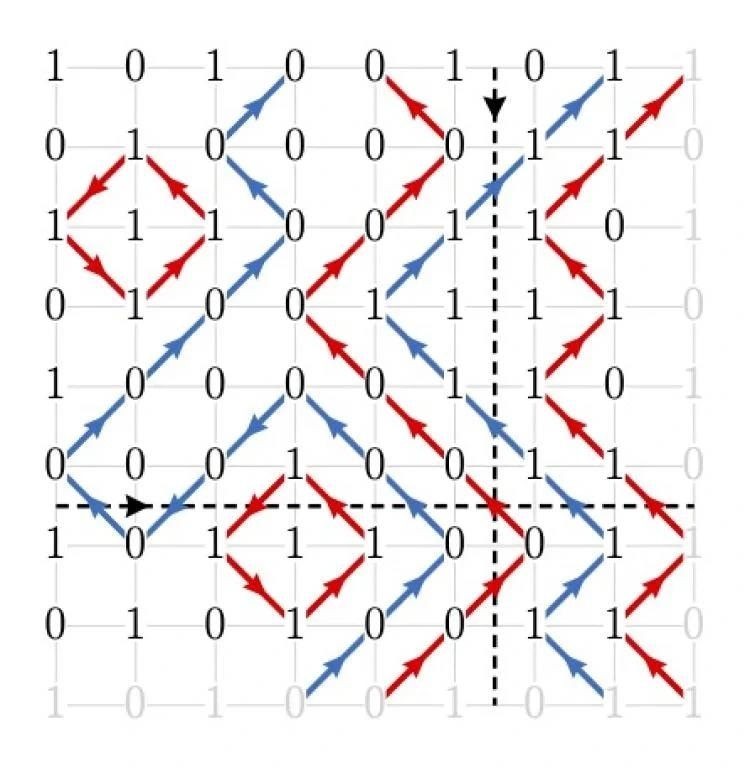The morning coffee will swirl with clouds of white liquid if a dash of creamer is added. But after a few seconds, those swirls will go, and it will be left with a regular brown liquid in a mug.

In the current study, Nandkishore and his colleagues used mathematical tools to envision a checkerboard pattern of theoretical qubits. The team discovered that if they arranged these zeros and ones in the right way, the patterns could flow around the checkerboard but might never disappear entirely. Image Credit: Stephen, Hart & Nandkishore
Information can quickly become jumbled in quantum computer chips, which are devices that tap into the strange features of the universe at its smallest scales. This limits the memory capacity of these devices.
That does not have to be the case, notes Rahul Nandkishore, Associate Professor of Physics at CU Boulder.
Using mathematical techniques, he and his colleagues have made a significant breakthrough in theoretical physics by demonstrating that it is possible to construct a situation in which milk and coffee do not mix, regardless of how vigorously they are stirred.
The team's research could result in improved quantum computer chips and give engineers new avenues to store data in minuscule items.
Think of the initial swirling patterns that appear when you add cream to your morning coffee; imagine if these patterns continued to swirl and dance no matter how long you watched.
Rahul Nandkishore, Senior Author and Associate Professor, Department of Physics, University of Colorado Boulder
To confirm that these infinite swirls are indeed feasible, more laboratory tests are required. However, the team's findings represent a significant advancement for physicists working on the project known as "ergodicity breaking," which aims to produce materials that stay out of equilibrium for extended periods of time.
The group's results were published in the journal "Physical Review Letters."
Quantum Memory
The study's universal issue in quantum computing is what drives co-authors David Stephen and Oliver Hart, postdoctoral physics researchers at CU Boulder.
Typically, "bits," which are represented by zeros or ones, power computers. Contrarily, Nandkishore clarified, quantum computers use "qubits," which are entities that can exist as either zero or one at the same moment due to the peculiarities of quantum mechanics.
Qubits have been created by engineers using a variety of materials, such as single atoms trapped by lasers or small components known as superconductors.
But qubits are readily confused, much like that cup of coffee. For instance, if every qubit is flipped to one, the qubits will ultimately flip back and forth until the chip as a whole becomes a disorganized mess.
In their recent research, Nandkishore and his colleagues may have identified a method to overcome the usual tendency of qubits to mix. The group conducted calculations suggesting that if scientists organize qubits into specific patterns, these configurations would preserve their information even when subjected to disturbances such as a magnetic field.
This finding raises the possibility of constructing devices with a form of quantum memory, according to the physicist.
This could be a way of storing information; you would write information into these patterns, and the information could not be degraded.
Rahul Nandkishore, Senior Author and Associate Professor, Department of Physics, University of Colorado Boulder
Tapping Into Geometry
In the study, an array of hundreds to thousands of qubits arranged in a checkerboard-like pattern was seen by the researchers using mathematical modeling techniques.
They found that packing the qubits into a small space was the key. According to Nandkishore, qubits can affect the actions of their neighbors if they are near enough to one another. It is similar to a throng of people attempting to cram themselves into a phone booth. Even if some of those individuals are either standing straight or on their heads, they are unable to turn around without shoving into other people.
According to their calculations, if these patterns were formed precisely, they may flow around a quantum computing chip and never break down, much like the clouds of cream that swirl indefinitely throughout the coffee.
Nandkishore said, “The wonderful thing about this study is that we discovered that we could understand this fundamental phenomenon through what is almost simple geometry.”
The team’s findings could influence a lot more than just quantum computers.
However, his recent discoveries add to the increasing amount of evidence that implies certain small matter organizations can resist that equilibrium, thereby defying some of the universe's most inflexible laws.
According to Nandkishore, nearly everything in the universe, from massive seas to coffee cups, tends to gravitate toward a state known as "thermal equilibrium." When you place an ice cube inside the mug, for instance, the heat from the coffee will cause the ice to melt and finally turn into a liquid that is all the same temperature.
We are not going to have to redo our math for ice and water. The field of mathematics that we call statistical physics is incredibly successful in describing things we encounter in everyday life. But there are settings where maybe it does not apply.
Rahul Nandkishore, Senior Author and Associate Professor, Department of Physics, University of Colorado Boulder
Journal Reference
Stephen, D. T., et.al., (2024). Ergodicity Breaking Provably Robust to Arbitrary Perturbations. Physical Review Letters. doi.org/10.1103/physrevlett.132.040401
Source: https://www.colorado.edu/